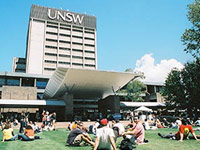|
||||||||||||||||||||||||||||||||||||||||||||
| Software Engineering/Science - 3651 | ||||||||||||||||||||||||||||||||||||||||||||

The stages of a generic combined program are shown below. It should be noted that it is possible to adapt the program by moving courses, subject to prerequisite requirements and the overall requirements given under Academic Rules below.
Day to day administration of this program is conducted through the Computer Science and Engineering Student Office, to which enquiries should be directed. Program Objectives and Learning Outcomes For further information please visit the school website at http://www.cse.unsw.edu.au/seng
Stage 1
And ONE of:
And ONE of:
Plus Level I Science electives (6 UOC)
Stage 2
Plus Level 2 Science electives (9 UOC)
Stage 3
Plus ONE of:
Plus SE Electives (21 UOC)
Plus Level 2 Science Electives (9 UOC) Stage 4
Level 2 or 3 Science electives (30 UOC)
Level 3 Science electives (12 UOC) Level 3 Science electives or SE Elective (6 UOC) Stage 5
SE Electives (24 UOC)
Honours will be awarded to students who have achieved superior grades in courses over the whole program including the successful completion of a thesis at sufficient standard. Weighted average marks required for Honours grades are given below: The School of Computer Science and Engineering uses an internal method for calculating this average, the information provided by myUNSW is not used for this purpose.
Honours Class 1: WA greater than or equal to 75 Honours Class 2: Division 1: WA equal to 70 up to and including 74 Honours Class 2 Divison 2: WA equal to 65 up to and including 69 The BE (Software Engineering)/BSc combined program requires the completion of 240uoc, including at least 84uoc of science courses, and must contain a major sequence of 42uoc at stages 2 and 3, with at least 18uoc at stage 3 in a single science discipline. To satisfy the requirement of the combined program, the free electives and the General Education electives of the standard Software Engineering program are assigned to science electives. The science content of the generic combined program consists of:
This yields a possible total of 90uoc of Science. Combined Programs are exempt from the General Education requirement.
The major Science discipline may not be Computer Science. Students who are enrolled in a combined program are expected to maintain a credit (65% or higher) average across courses taken from each of the composite programs. Students who fail to meet this condition will be counselled about their suitability to remain in the combined program. Refer to the School of Computer Science and Engineering web page for examples of specific SE/Science programs. www.cse.unsw.edu.au/seng For information regarding fees for UNSW programs, please refer to the following website: https://my.unsw.edu.au/student/fees/FeesMainPage.html
Industrial Training Requirements All students in the BE in Computer Engineering, Bioinformatics Engineering and Software Engineering programs must complete at least 60 days of approved Industrial Training before the end of Year 4.
Further Information and Requirements Some courses listed here also offer advanced versions
Computing Requirements
Information regarding recommended computing equipment and software for the progam is available from the School,of Computer Science and Engineering Help Desk.
Engineers Australia
The professional body for engineering in Australia is Engineers Australia, which has as its first objective the promotion of the science and practice of engineering in all its branches. Engineers Australia has its national headquarters in Canberra and functions through a series of divisions, the local one being the Sydney Division. Within each division are branches representing the main interests within the profession, e.g. civil, mechanical, electrical, engineering management and environmental engineering. Students of an approved school of engineering may join the Institution as a student member (StudIEAust). Student members receive the monthly publication Engineers Australia and for a small fee they also receive The Transactions which contains articles on a particular branch of engineering. Student members are invited to participate in the Excellence Award for Work Experience, the National Young Engineer of the Year Award and to avail themselves of other Engineers Australia services including the Mentor Scheme and industrial experience guidance. For more information and membership application forms, contact Engineers Australia, Sydney Division, Level 3, 8 Thomas Street, CHATSWOOD NSW 2067 - telephone 02 9410 5600 www.engineersaustralia.org.au The Australian Computing Society The peak professional body for computing in Australia is the Australian Computing Society (ACS) - www.acs.org.au The objectives of the ACS can be found here and include: "advanc[ing] professional excellence in information and communications technology, and further[ing] the study, science and application of information and communications technology." Again, students who want to join ACS should go to Member Application Area(s) of Specialisation |
||||||||||||||||||||||||||||||||||||||||||||


